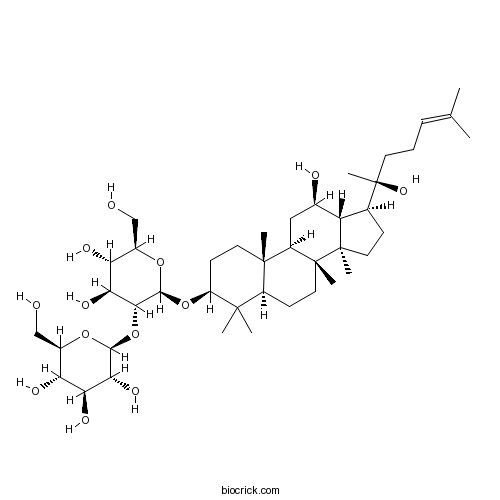A ginsenoside found in Panax ginseng and Panax japonicus var. major that is dammarane which is substituted by hydroxy groups at the 3β, 12β and 20 pro-S positions, in which the hydroxy group at position 3 has been converted to the corresponding β-D-glucopyranosyl-β-D-glucopyranoside, and in which a double bond has been introduced at the 24-25 position.
InChI=1S/C42H72O13/c1-21(2)10-9-14-42(8,51)22-11-16-41(7)29(22)23(45)18-27-39(5)15-13-28(38(3,4)26(39)12-17-40(27,41)6)54-37-35(33(49)31(47)25(20-44)53-37)55-36-34(50)32(48)30(46)24(19-43)52-36/h10,22-37,43-51H,9,11-20H2,1-8H3/t22-,23+,24+,25+,26-,27+,28-,29-,30+,31+,32-,33-,34+,35+,36-,37-,39-,40+,41+,42-/m0/s1
Ginsenoside-Rg3, possess an ability to inhibit the lung metastasis of tumor cells, and the mechanism of their antimetastatic effect is related to inhibition of the adhesion and invasion of tumor cells, and also to anti-angiogenesis activity.[1]
Ginsenoside-Rg3 (2.5 or 5.0 mg/kg body weight,s.c. injections) inhibits cancer metastasis through activities that do not affect the growth or vascularity of intestinal cancers.[2]
Ginsenoside Rg3 has anti-tumor property through its angiosuppressive activity, is a ginsenoside monomer with high anti-cancer activity.[3,4]
Ginsenoside-Rg3 has new pharmacological activity against testosterone-induced prostate overgrowth,downregulates AR by facilitating the degradation of AR protein, could be potential therapeutic regimens for treating BPH.[5]
Ginsenoside-Rg3 is a novel drug, capable of inhibiting the early of scarring (HS) and later HS. GS-Rg3/electrospun is a very promising new treatment for early and long-term treatment of HS.[6]
English website: Ginsenoside Rg3
Japanese website: Ginsenoside Rg3
Chinese website: Ginsenoside Rg3
[1] Mochizuki M, Yoo Y C, Matsuzawa K, et al. Biol Pharm Bull, 1995, 18(9):1197-202.
[2] Iishi H, Tatsuta M, Baba M, et al. Clin Exp Metastas , 1997, 15(6):603-11.
[3] Yue P Y K, Wong D Y L, Wu P K, et al. Biochem Pharmcol, 2006, 72(4):437-45.
[4] Xue-Long L I, Yao-Yao F U, Sun S Y, et al. Journal of Dalian Polytechnic University, 2010,29(6):396-8.
[5] Bae J S, Park H S, Park J W, et al. J Nat Med, 2012, 66(3):476-85.
[6] Cheng L, Sun X, Hu C, et al. Acta Biomater, 2013, 9(12):9461-73.
[7] Zhao Q, Zheng X, Jiang J, et al. J Chromatogr B , 2010, 878(24): 2266-73.



